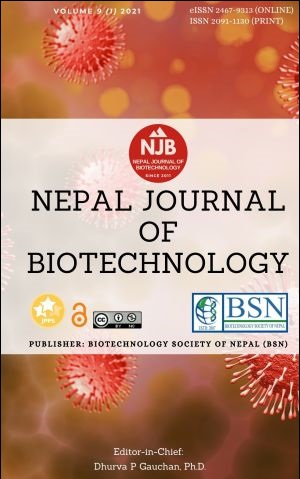Antibiogram and Phytochemical Analysis of Cinnamon, Clove, and Sichuan Pepper Extracts
DOI:
https://doi.org/10.3126/njb.v9i1.38644Keywords:
Antimicrobial activity, DMSO, Ethanol, Methanol, PhytochemicalsAbstract
A wide range of medicinal plant extracts has phytochemicals that possess antimicrobial properties and these plants are used to treat several infections. The study aimed to assess the antimicrobial activities of some spices extracts and to evaluate the phytochemicals present in them. The extracts of spices were prepared using Soxhlet apparatus refluxing with methanol and ethanol. The well diffusion technique was implemented for the evaluation of antimicrobial activities of the extracts and the zone of inhibitions was recorded in millimeters. The antimicrobial test was done against five bacterial isolates: Escherichia coli, Proteus mirabilis, Pseudomonas aeruginosa, Salmonella enterica serotype Typhi, and Staphylococcus aureus and a fungal isolate: Candida albicans. The extracts were concentrated by Rotary Vacuum Evaporator and a stock solution of 200 mg/mL was prepared by dissolving in 10 % DMSO. Concentrations of 40, 60, 80 and 100 mg/mL extracts were used for antimicrobial activity. The result of this study showed that clove extracts had the highest antimicrobial property against all the test microorganisms. Methanolic extract of clove had the highest inhibitory effect against Proteus mirabilis (24.21±0.15 mm), Pseudomonas aeruginosa (19.78±0.23 mm), and Candida albicans (20.07±0.08 mm) whereas ethanolic extract was effective against Escherichia coli (20.44±0.16 mm), Salmonella Typhi (21.66±0.31 mm) and Candida albicans (21.11±0.09 mm). Cinnamon and pepper extracts, leaving some exceptions, also had antimicrobial properties. The presence of phytochemicals: polyphenols, flavonoids, and tannins are the major components responsible for antimicrobial activity. Thereby, this study successfully demonstrated the possibilities of using spices extracts in the treatment of microbial infections.
Downloads
Downloads
Published
How to Cite
Issue
Section
License
Copyright (c) 2021 Biotechnology Society of Nepal

This work is licensed under a Creative Commons Attribution-NonCommercial 4.0 International License.
Copyright Notice:
The manuscript submitted to NJB must be an original contribution, not previously published and should not be under consideration for publication elsewhere. When the manuscript is accepted for publication, the authors agree to automatically transfer the copyright of the article to the publisher. It should grant permission to any third party, in advance and in perpetuity, the right to use, reproduce or disseminate your article, according to the NJB copyright and license agreement.
Authors transfer copyright to the publisher as part of a journal publishing agreement but have the rights to: Share their article for Personal Use, Internal Institutional Use and Scholarly Sharing purposes, with the NJB applies the Creative Commons Attribution-NonCommercial CC BY-NC license to all the works we publish after Jun 2020 (Before it was CC BY-NC-ND). Under this license, authors agree to make articles legally available for reuse, without permission or fees, for virtually any non-commercial purpose. Anyone may remix, adapt, and build upon your work non-commercially, and although their new works must also acknowledge you and be non-commercial, they don’t have to license their derivative works on the same terms. More details on CC BY-NC refer to its Licence Deed and Legal Code.






